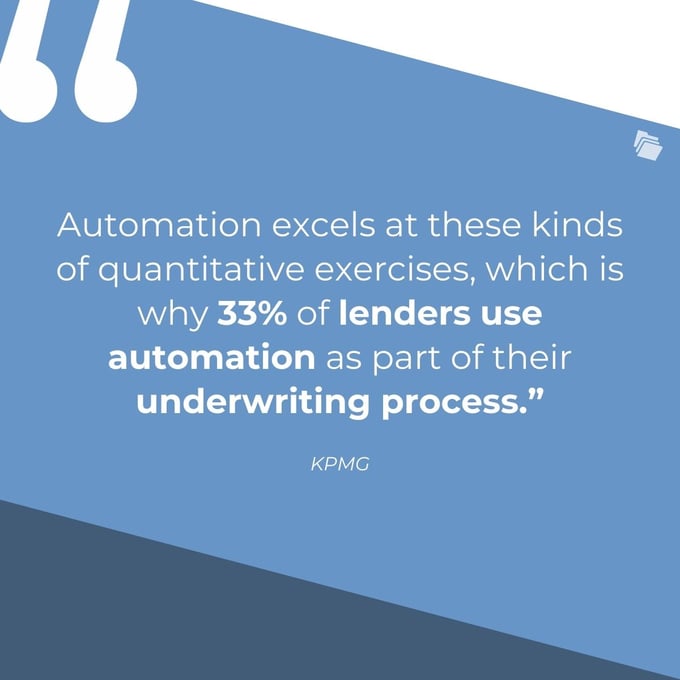Today’s lenders face unprecedented challenges: high-interest rates, increased demand after a slow 2023, persistent liquidity challenges, and rapidly changing consumer expectations. Commercial lending hit a peak of $2.8 billion in January 2023, falling just short of the all-time high of $3 billion in May 2020. Since hitting that milestone, commercial loan volume has gradually tapered off in 2023 and the early parts of 2024.
To combat these new challenges, new automation tools are helping lenders stay productive and profitable in 2024. Loan automation reduces the manual workload for lenders, allowing them to accomplish more with fewer resources.
Automation also improves the customer experience by streamlining the application and document submittal process. About 85% of global banks have used AI to automate some part of their lending process. The net result is less frustration, better communication, and faster processing times.
In this guide, we’ll explain how loan automation is helping employees and borrowers through the three stages of the commercial loan lifecycle: origination, underwriting, and servicing.

The Start of the Journey: Loan Origination
From the first moment of contact between lender and borrower, automation plays a key role. Before the borrower even submits their initial application, many lenders are already using customer relationship management (CRM) tools to nurture their relationships and generate leads.
CRMs and Lead Qualification
A CRM doesn’t replace human interaction – that’s best left to loan officers and customer service reps. What a CRM does is complement the strengths and weaknesses of human workers, keeping the best aspects of human interpersonal relationships and contributing the analytical and record-keeping power of technology. A CRM helps loan officers organize leads, schedule follow-ups, and maintain consistent records without relying on a Rolodex or notes jotted in a calendar.
When a CRM is successful at helping lenders build relationships with their prospective borrowers, the next stage of the origination process is the submission of an initial application.
Initial Application and Documentation
During their initial application, the borrower fills out the lender’s application document. For instance, to apply for an SBA loan, borrowers will fill out SBA form 1919. While each financial institution sets its own requirements for loan programs, this initial application for commercial loans usually requires at least the following basic information:
- Personal information, such as the applicant’s name, birthdate, taxpayer identification number (TIN), and contact information
- Information about the business, such as its address, industry, employer identification number (EIN), and key stakeholders
- Financial information, such as a business and personal credit score as well as business and personal financial statements (income statements, tax forms, statements of cash flows, etc.) to establish creditworthiness
- Information about how funds will be used. Depending on the type of commercial loan, some financial products (like SBA 504 loans) have strict guidelines for how borrowers can use funds, while other products (like business lines of credit) are more open-ended
Traditionally, borrowers would submit their applications on paper and in-person, but that practice is quickly changing in the 2020s. Today, many lenders use online portals to collect applications. These document portals speed up the application process, allowing borrowers to upload documents at their convenience and allowing lenders to quickly process and evaluate the applications once they receive them. Online submissions also help lenders and borrowers stay organized – they create a centralized hub for communication and documentation so documents can’t get lost in email threads or stacks of papers.

Evaluating New Applications
Once the borrower submits their application, the lender must process and evaluate it. Application processing is traditionally a time-consuming and labor-intensive process, prone to human error and inconsistent procedures. That makes application processing the perfect use case for automation.
Automated loan processing tools can quickly ingest and organize documents, but they can also perform preliminary analysis on the application. Once again, loan automation doesn’t replace the human judgment involved in loan underwriting (the next stage of the loan process), but rather enhances the strengths and supplements the weaknesses of human loan officers.
Loan automation tools increase efficiency, improve data accuracy, and ultimately result in a better experience for borrowers and employees – the #1 targeted area of improvement for 43% of lenders. Borrowers enjoy the easy application process and faster processing times, while lenders enjoy the reduced workload and increased productivity.
The Decision Point: Loan Underwriting
During the loan origination stage, lenders commonly use automation tools to perform preliminary assessments. These assessments help lenders “score” applications to determine their preliminary eligibility. However, these automations are based on a limited number of factors and don’t provide a complete picture of the borrower’s creditworthiness.
Commercial lenders’ underwriting guidelines are generally more complex than their basic application eligibility requirements. The initial assessment gets borrowers in the door, but before they walk out with money in hand, the lender will perform more advanced underwriting to determine their creditworthiness and ability to repay. The underwriting requirements for a commercial loan usually involve the following factors, among others:
Debt To Income Ratio (DTI)
Debt to Income ratio (DTI) measures how much of a business’s income is spent repaying debts. Lenders calculate DTI very simply: monthly debt payments divided by monthly income. A DTI of 0.8 (or 80%) would suggest that the business spends 80% of its income paying for existing debts, which could significantly limit its ability to repay an additional loan. A more favorable DTI like 0.3 (or 30%) would suggest that the business only spends 30% of its income on existing debts and therefore may have the ability to take on more debt without jeopardizing its finances.
Loan To Value Ratio (LTV)
Loan to Value ratio (LTV) is commonly used in commercial real estate transactions because it measures what percentage of the property’s value is covered by the loan. Like DTI, the calculation for LTV is very simple: the amount of the loan divided by the value of the property. For example, a business taking out a $750,000 mortgage on a $1 million property would have an LTV of 0.75 (or 75%). A low LTV is favorable because it signifies that the collateral is worth more than the loan, which translates to less risk for the lender.
Other Ratios
Other ratios like the coverage ratio (future loan payments divided by anticipated income) and inventory turnover ratio (cost of goods sold divided by average inventory) give lenders better insight into more specific aspects of a business’s finances. The specifics can depend on the industry, the type of loan product, and other unique factors.
Automation excels at these kinds of quantitative exercises, which is why 33% of lenders use automation as part of their underwriting process.

However, underwriting also involves qualitative judgments about the viability of the business, its history, how it intends to use funds, etc. These kinds of decisions depend on the experience and judgment of human underwriters, but automation can still help. Today, lenders use AI and machine learning to augment human decision-making with a data-driven approach. While AI can’t account for the human factors of a commercial loan, it can provide backing for the underwriters’ decisions and help them identify blind spots in their analysis.
Happily Ever After: Loan Servicing
As long as the borrower meets the lender’s underwriting requirements, the underwriting process ends with loan closing and funding. Automation has helped the lender make sound decisions more quickly and efficiently throughout the loan process, and now automation will help the lender maintain the loan throughout its lifetime.
The CRM tools lenders use to qualify leads also help lenders maintain relationships with their customers. In fact, behind lead generation, which comprises 27.8% of CRM focus, customer management, and support are the leading use cases of CRMs. CRMs do this by automating messages (such as payment reminders and notices of scheduled interest rate adjustments), tracking activity, and providing self-service options for borrowers to resolve issues as they arise. By 2028, the CRM market is projected to grow to around $130 billion.
Most lenders also automate the payment process, allowing borrowers to set up recurring payments. Automated payments are more convenient for borrowers and favorable for lenders because they reduce the likelihood that a borrower will miss a payment and default on their loan.
Automation also helps with customer service. In addition to the self-servicing options some CRMs provide, lenders can use tools like automated chatbots to connect borrowers to immediate help without putting pressure on their customer service team.
Embracing Commercial Loan Automation
Automation tools like CRMs, risk evaluation software, and application scoring systems help commercial lenders stay effective and efficient. By leveraging automation across the lending lifecycle, lenders set borrowers and employees up for success.
Get a personalized FileInvite demo.

Related Posts: